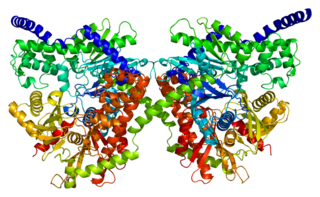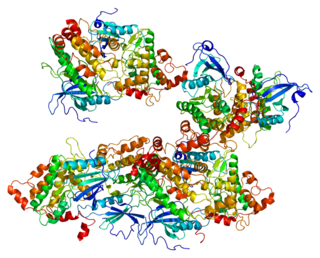
Peptidylprolyl isomerase A (PPIA), also known as cyclophilin A (CypA) or rotamase A is an enzyme that in humans is encoded by the PPIA gene on chromosome 7. As a member of the peptidyl-prolyl cis-trans isomerase (PPIase) family, this protein catalyzes the cis-trans isomerization of proline imidic peptide bonds, which allows it to regulate many biological processes, including intracellular signaling, transcription, inflammation, and apoptosis. Due to its various functions, PPIA has been implicated in a broad range of inflammatory diseases, including atherosclerosis and arthritis, and viral infections.

Hexokinase-1 (HK1) is an enzyme that in humans is encoded by the HK1 gene on chromosome 10. Hexokinases phosphorylate glucose to produce glucose-6-phosphate (G6P), the first step in most glucose metabolism pathways. This gene encodes a ubiquitous form of hexokinase which localizes to the outer membrane of mitochondria. Mutations in this gene have been associated with hemolytic anemia due to hexokinase deficiency. Alternative splicing of this gene results in five transcript variants which encode different isoforms, some of which are tissue-specific. Each isoform has a distinct N-terminus; the remainder of the protein is identical among all the isoforms. A sixth transcript variant has been described, but due to the presence of several stop codons, it is not thought to encode a protein. [provided by RefSeq, Apr 2009]

DnaJ homolog subfamily A member 3, mitochondrial, also known as Tumorous imaginal disc 1 (TID1), is a protein that in humans is encoded by the DNAJA3 gene on chromosome 16. This protein belongs to the DNAJ/Hsp40 protein family, which is known for binding and activating Hsp70 chaperone proteins to perform protein folding, degradation, and complex assembly. As a mitochondrial protein, it is involved in maintaining membrane potential and mitochondrial DNA (mtDNA) integrity, as well as cellular processes such as cell movement, growth, and death. Furthermore, it is associated with a broad range of diseases, including neurodegenerative diseases, inflammatory diseases, and cancers.

Diablo homolog (DIABLO) is a mitochondrial protein that in humans is encoded by the DIABLO gene on chromosome 12. DIABLO is also referred to as second mitochondria-derived activator of caspases or SMAC. This protein binds inhibitor of apoptosis proteins (IAPs), thus freeing caspases to activate apoptosis. Due to its proapoptotic function, SMAC is implicated in a broad spectrum of tumors, and small molecule SMAC mimetics have been developed to enhance current cancer treatments.

DNA damage-inducible transcript 3, also known as C/EBP homologous protein (CHOP), is a pro-apoptotic transcription factor that is encoded by the DDIT3 gene. It is a member of the CCAAT/enhancer-binding protein (C/EBP) family of DNA-binding transcription factors. The protein functions as a dominant-negative inhibitor by forming heterodimers with other C/EBP members, preventing their DNA binding activity. The protein is implicated in adipogenesis and erythropoiesis and has an important role in the cell's stress response.

Serine protease HTRA2, mitochondrial is an enzyme that in humans is encoded by the HTRA2 gene. This protein is involved in caspase-dependent apoptosis and in Parkinson's disease.

Deleted in Liver Cancer 1 also known as DLC1 and StAR-related lipid transfer protein 12 (STARD12) is a protein which in humans is encoded by the DLC1 gene.

28S ribosomal protein S29, mitochondrial, also known as death-associated protein 3 (DAP3), is a protein that in humans is encoded by the DAP3 gene on chromosome 1. This gene encodes a 28S subunit protein of the mitochondrial ribosome (mitoribosome) and plays key roles in translation, cellular respiration, and apoptosis. Moreover, DAP3 is associated with cancer development, but has been observed to aid some cancers while suppressing others.

Death-associated protein kinase 2 is an enzyme that in humans is encoded by the DAPK2 gene.

Transforming growth factor beta regulator 4 (TBRG4), also known as cell cycle progression restoration protein 2 (CPR2) and FAST kinase domain-containing protein 4 (FASTKD4), is a protein that in humans is encoded by the TBRG4 gene on chromosome 7. This protein is part of the FASTKD family, which is known for regulating the energy balance of mitochondria under stress and cell cycle progression. TBRG4 is involved in cell proliferation in hematopoiesis and multiple myeloma.

Phospholipid scramblase 3 is an enzyme that in humans is encoded by the PLSCR3 gene. Like the other phospholipid scramblase family members, PLS3 is a type II plasma membrane protein that is rich in proline and integral in apoptosis, or programmed cell death. The regulation of apoptosis is critical for both cell development and tissue homeostasis

Hexokinase 2 also known as HK2 is an enzyme which in humans is encoded by the HK2 gene on chromosome 2. Hexokinases phosphorylate glucose to produce glucose-6-phosphate (G6P), the first step in most glucose metabolism pathways. This gene encodes hexokinase 2, the predominant form found in skeletal muscle. It localizes to the outer membrane of mitochondria. Expression of this gene is insulin-responsive, and studies in rat suggest that it is involved in the increased rate of glycolysis seen in rapidly growing cancer cells. [provided by RefSeq, Apr 2009]
When overexpressed ectopically, anticancer genes are those that preferentially kill cancer cells while sparing normal, healthy cells. Apoptosis, necrosis, or apoptosis following a mitotic catastrophe, and autophagy are only a few of the processes that can lead to cell death. In the late 1990s, research on cancer cells led to the identification of anticancer genes. Currently, 291 The human genome contains anti-cancer genes. Base substitutions that lead to insertions, deletions, or alterations in missense amino acids that cause frameshifts that alter the protein that the gene codes for copy number variations or gene rearrangements that lead to their deregulation are all necessary for a gene change in copy number or gene rearrangements. (1)

FAST kinase domain-containing protein 3 (FASTKD3) is a protein that in humans is encoded by the FASTKD3 gene on chromosome 5. This protein is part of the Fas-activated serine/threonine kinase domain (FASTKD) containing protein family, which is known for regulating the energy balance of mitochondria under stress.

ADP/ATP translocase 2 is a protein that in humans is encoded by the SLC25A5 gene on the X chromosome.

FAST kinase domain-containing protein 2 (FASTKD2) is a protein that in humans is encoded by the FASTKD2 gene on chromosome 2. This protein is part of the FASTKD family, which is known for regulating the energy balance of mitochondria under stress. FASTKD2 has been implicated in mitochondrial encephalomyopathy, breast cancer, and prostate cancer.

FAST kinase domain-containing protein 5 (FASTKD5) is a protein that in humans is encoded by the FASTKD5 gene on chromosome 20. This protein is part of the FASTKD family, which is known for regulating the energy balance of mitochondria under stress. FASTKD5 is also required for RNA granules to process precursor mRNAs not flanked by tRNAs.

Human growth and transformation-dependent protein (HGTD-P), also called E2-induced gene 5 protein (E2IG5), is a protein that in humans is encoded by the FAM162A gene on chromosome 3. This protein promotes intrinsic apoptosis in response to hypoxia via interactions with hypoxia-inducible factor-1α (HIF-1α). As a result, it has been associated with cerebral ischemia, myocardial infarction, and various cancers.

Regulator of microtubule dynamics protein 3 (RMDN3), more commonly known as Protein tyrosine phosphatase interacting protein 51 (PTPIP51), is a protein that in humans is encoded by the RMDN3 gene on chromosome 15. This protein contributes to multiple biological functions, including cellular differentiation, proliferation, motility, cytoskeleton formation, and apoptosis, and has been associated with numerous cancers.

Histidine triad nucleotide binding protein 2 (HINT2) is a mitochondrial protein that in humans is encoded by the HINT2 gene on chromosome 9. This protein is an AMP-lysine hydrolase and phosphoamidase and may contribute to tumor suppression.





















